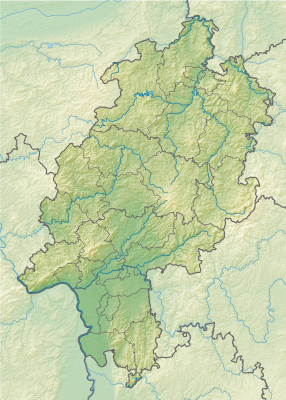Höckelsburg
| Höckelsburg | ||
|---|---|---|
| Alternative name (s): | Heckelsburg, Hoekesborg (1486), Hoebelsburgk (1555), Hugelsburg (1587) | |
| Creation time : | between the Iron Age and the La Tène Age | |
| Castle type : | Höhenburg, Spornlage, Wallburg | |
| Conservation status: | Wall remains | |
| Standing position : | rural refuge | |
| Place: | Herzhausen (Vöhl) | |
| Geographical location | 51 ° 11 '42 " N , 8 ° 53' 6" E | |
| Height: | 407 m above sea level NHN | |
|
|
||
The Höckelsburg is Outbound and probably between the Iron Age or the Celts resulting hilltop castle site and is located about 1.5 km north-northwest of Herzhausen , but in the district of Thalitter , both vilage of Vöhl in Waldeck-Frankenberg , Hessen ( Germany ).
location
The remains of the former Fliehburg are located in the northern part of the Kellerwald-Edersee Nature Park in a forest area on the summit of the Höckelsburg (also known as Heckelsburg). The elongated mountain running in north-south direction has a height of 407 m above sea level. NN and lies between the valleys of the Itter in the east and the Wennenbach in the west. The federal road 252 runs from Frankenberg to Korbach along its eastern flank, in the Itter valley .
You can reach the facility by parking about 1 km north of Herzhausen at the rest area on the B 252, taking the bridge over the Itter to the west and then turning right (north) shortly before reaching the Wennebach Valley. After reaching the height, forest paths lead south to the former castle. The less arduous ascent leads over the Höhenweg, which turns left (south) from Immighäuser Straße west above Thalitter and leads through fields and woods far above the Ittertal to the Höckelsburg.
The attachment
The mountain drops very steeply on both sides and at its southern tip. This elongated triangular peak of the mountain is essentially flat and sealed off to the north by an approximately 80-meter-long wall running across the ridge , through which, however, a path was broken during the forestry development. The wall should originally have been a wall about four meters high and consisted for the most part of greywacke stones and beams. In its center there are now relatively light, tuff-like, porous , partially sintered stones interspersed with white quartz grains , so that one speaks of a " cinder wall ". In order to destroy it, attackers apparently set a large fire on the wall, which led to slagging and sintering of the Grauwacken and the collapse of the wall.
Neither the time of construction nor that of the destruction are known with certainty, but it is assumed that the complex was built about 500 years before the beginning of the Christian era, at the beginning of the La Tène period , and that it was built about a hundred years ago by the Chatten our era was destroyed.
Since the Fliehburg was later in the border area between Chatten and Saxony , it may have served as a place of refuge again after its destruction and in the Saxon Wars of Charlemagne .
Others
The plant is not with the approximately 7.4 kilometers to the southeast below Basdorf located Hünselburg to be confused, which is also regarded as a Celtic conditioning. In the literature both are confused several times.
Individual evidence
- ^ Hünselburg, Waldeck-Frankenberg district. Historical local dictionary for Hesse (as of December 14, 2012). In: Landesgeschichtliches Informationssystem Hessen (LAGIS). Hessian State Office for Historical Cultural Studies (HLGL), accessed on December 14, 2012 .
Web links
- The Höckelsburg - an old Celtic festival on the website of the municipality of Vöhl
- Heckelsburg, Waldeck-Frankenberg district. Historical local dictionary for Hessen. In: Landesgeschichtliches Informationssystem Hessen (LAGIS).



